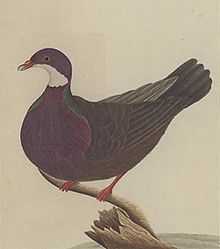George Raper
George Raper (19 September 1769 – 29 September 1797) was a naval officer and illustrator.
Career
Raper was born to Henry and Catherine Raper in London, England on 19 September 1769. On 20 August 1783 he joined the Royal Navy's HMS Rose as a captain's servant. After further service on HMS Racehorse, he joined HMS Sirius on 15 November 1786. Sirius, commanded by Captain John Hunter, was the flagship of the First Fleet, which under Commodore Arthur Phillip transported convicts from England to New South Wales in Australia. On 30 September 1787, while the First Fleet was sailing from Rio de Janeiro to Cape Town, George Raper became a midshipman. Raper took his paint box with him, containing a larger set of paints than that of his captain, John Hunter, who was also an artist. Raper's charts, and his paintings of ports such as Teneriffe and Rio de Janeiro, were part of his evidence of competence for his promotion to midshipman. The First Fleet arrived in Botany Bay in January 1788.
On 2 October 1788, Sirius with Raper on board set sail from Port Jackson for the Dutch settlement of Cape Town, to get supplies for the starving Australian colony. Raper continued to paint; his watercolour of 'ice-islands' on this journey is held at the Natural History Museum, London. In February 1789, Sirius left Cape Town loaded with twelve months provisions for the ship’s company, six months flour for the whole settlement and other stores. Raper probably purchased paper in Cape Town; most of his paintings after this date are on Dutch paper.
On the return to Port Jackson, Sirius suffered damage in a gale off the south coast of Van Diemen's Land. Ths ship was repaired at Careening Cove, now Mosman Bay on Sydney Harbour, from June to November 1789. During this period, Raper may have had leisure to continue his painting.
On 6 March 1790, Sirius, with Raper on board, left Port Jackson for Norfolk Island. On 19 March, Sirius was wrecked while landing supplies at Norfolk Island. All the ship's company were saved and many of the supplies were salvaged. Raper saved his paint box. A number of the landscapes and natural history drawings that he made on the island have survived. He and the crew of Sirius spent an enforced 11 months on the island, facing starvation and increasing distress at the failure of Governor Phillip to send a ship to collect them. Raper and the rest of the ship's company eventually returned to Sydney with HMS Supply, arriving there on 27 February 1791.
Back in England in 1792, the officers of Sirius, including Raper, faced a court martial because of the loss of the ship. They were honourably acquitted.
Raper then served on HMS Duke and HMS Victory. In June 1793 he received his commission as lieutenant and moved to HMS Speedy. In September that year he moved to the former French ship Commerce de Marseille, one of the vessels which had defected to the British during the Siege of Toulon; his presence is recorded in that ship's muster as 'Rapert ... Lieut't anglais'. Only two paintings that can be dated to his period of service in the Mediterranean are known to have survived - they are of a dolphin and a shark, and are held at the State Library of New South Wales.
In April 1795 Raper joined HMS Cumberland as a lieutenant. While serving on the Cumberland, he wrote his will. Dated 14 October 1795, it is a simple document compared to most 18th-century wills. In it he asks that his painting case 'be delivered ...to my dearest and beloved Mother'.
In May 1796, Raper was given his first command, as master and commander of the cutter HMS Expedition. He was despatched to Gibraltar and then the West Indies, bringing his ship through a hurricane near Barbados with much damage but no lives lost. A letter from Vice-Admiral Sir Hyde Parker dated 2 October 1796 reported Raper's death: 'I am sorry to conclude my letter with informing their Lordships that Lieutenant Raper, commanding the Expedition Cutter, died on the 29th'. There are reports of multiple deaths from fever on Royal Navy vessels in the West Indies in the preceding months. The Admiral’s letter and other naval records of the time, however, make no comment on whether Raper succumbed to the fever or died from some other cause.
Paintings
On his travels from 1787 to 1792, George Raper drew watercolour paintings of birds, flowers and landscapes. Many of these drawings show species which are extinct today, like the Lord Howe Swamphen or the Lord Howe Pigeon from Lord Howe Island. He also sketched profiles of landscapes and topographical maps. These pictures can be seen in the First Fleet Artwork Collection in the Natural History Museum in London and in the Alexander Turnbull Library in Wellington, New Zealand.
In 2004, 56 long-lost watercolours were found at the estate of the Earl of Ducie, England. The National Library of Australia has bought this collection for an undisclosed sum from the Moreton family in England.
Gallery
-

Wa-ra-ta (Telopea speciosissima)
-
_-cropped.jpg)
"Handsome flat-pea (Platylobium formosum)"[1789?]
-
.jpg)
Crinum pedunculatum, detail of flower and seeds above image of whole plant.
-

Phaps chalcoptera
-

Columba vitiensis godmanae
External links
| Wikimedia Commons has media related to George Raper. |
- George Raper biography
- The George Raper Collection On line exhibition.
- First Fleet Artwork Collection Slow to load.
- Australian Dictionary of Biography
- Watercolours attributed to George Raper. Ducie Collection of First Fleet art at Pictures Branch, National Library of Australia, Canberra
|